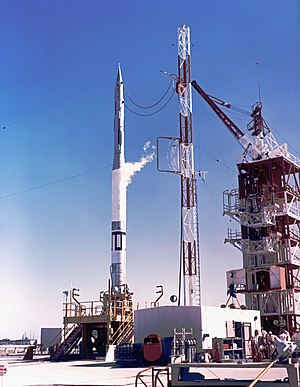Vanguard TV-5
 Vanguard rocket on LC-18A prior to its launch | |
| Names | Vanguard Test Vehicle-Five |
|---|---|
| Mission type | Earth science |
| Operator | U.S. Navy |
| Mission duration | Failed to orbit |
| Spacecraft properties | |
| Spacecraft | Vanguard TV-5 |
| Spacecraft type | Vanguard |
| Manufacturer | Naval Research Laboratory |
| Launch mass | 9.75 kg (21.5 lb) |
| Dimensions | 50.8 cm (20.0 in) of diameter |
| Start of mission | |
| Launch date | 29 April 1958, 02:53:00 GMT |
| Rocket | Vanguard TV-5 |
| Launch site | Cape Canaveral, LC-18A |
| Contractor | Glenn L. Martin Company |
| End of mission | |
| Decay date | Failed to orbit |
| Orbital parameters | |
| Reference system | Geocentric orbit (planned) |
| Regime | Medium Earth orbit |
| Perigee altitude | 655 km |
| Apogee altitude | 3970 km |
| Inclination | 34.20° |
| Period | 134.0 minutes |
Vanguard TV-5, also called Vanguard Test Vehicle-Five, was a failed flight of the American Vanguard rocket following the successful launch of Vanguard 1 on Vanguard TV-4. Vanguard TV-5 launched on 29 April 1958 at 02:53:00 GMT, from Launch Complex 18A at the Cape Canaveral Air Force Station. The rocket was unsuccessful in its attempt to place an unnamed satellite into orbit.[1]
Background
After three successful flight tests, which proved the Vanguard rocket's first stage and internal telemetry systems (
On 17 March 1958, however, Vanguard 1 was successfully launched into orbit, marking the first full triumph for the project. The next step would be to launch a full-sized, instrumented Vanguard.[3]: 283 For that purpose, TV-4BU, a back-up rocket identical to the TV-4 that had launched Vanguard 1, was converted to carry the larger satellite.[3]: 223

Spacecraft
Vanguard TV5's satellite was a 9.75 kg (21.5 lb), 50.8 cm (20 inches) diameter sphere whose shell was composed of magnesium coated with highly polished silicon monoxide. A 108.00
Mission
TV-5's first stage was erected on the firing stand at Launch Complex 18A by the first week of April. However, by then, the pad managers had viewed the flight film from TV-4 and determined that the hydraulic disconnects had not separated smoothly from the rocket at liftoff. A new, pull-away firing structure was under construction, but it would not be completed for some time. As a result, modifications were made to the existing, static stand.[3]: 223
Vanguard TV-5 was launched on 29 April 1958 at 02:53:00 GMT (28 April 1958, 21:53:00 ET),
The program achieved success in the following year with the launch of
See also
- Vanguard rocket
- Project Vanguard
- Comparison of orbital launch systems
- Comparison of orbital rocket engines
- Rocket
- Spacecraft propulsion
References
- ^ McDowell, Jonathan. "Launch Log". Jonathan's Space Report. Retrieved 24 April 2019.
- ^ "Vanguard Project". Naval Research Laboratory. Retrieved 24 April 2019.
 This article incorporates text from this source, which is in the public domain.
This article incorporates text from this source, which is in the public domain.
- ^ ISBN 978-1-97353-209-5. SP-4202..
 This article incorporates text from this source, which is in the public domain
This article incorporates text from this source, which is in the public domain - ^ a b "Vanguard TV5". NASA. 14 May 2020. Retrieved 2 February 2021.
 This article incorporates text from this source, which is in the public domain.
This article incorporates text from this source, which is in the public domain.
- ^ "NASA, X-Ray Experiment, Vanguard 3". NASA. Retrieved 24 April 2019.
 This article incorporates text from this source, which is in the public domain.
This article incorporates text from this source, which is in the public domain.
- ^ .
- ISBN 978-1-85109-519-3.
Further reading
- Mallove, Eugene F. and Matloff, Gregory L. The Starflight Handbook: A Pioneer's Guide to Interstellar Travel, Wiley, ISBN 0-471-61912-4
